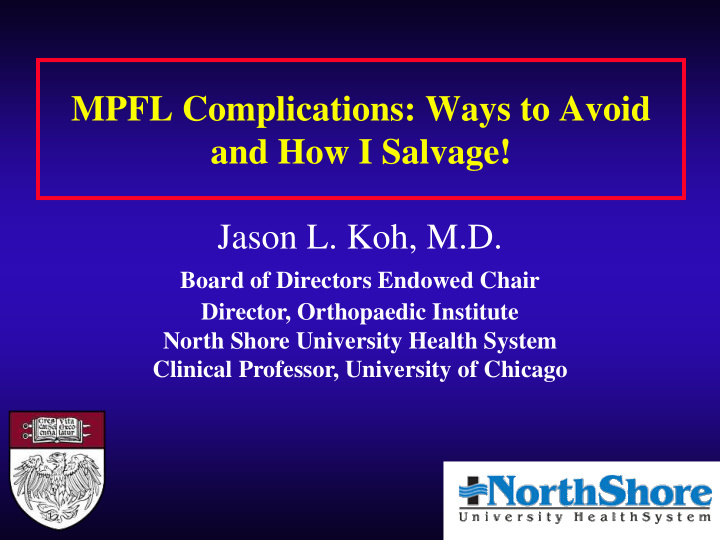



MPFL Complications: Ways to Avoid and How I Salvage! Jason L. Koh, M.D. Board of Directors Endowed Chair Director, Orthopaedic Institute North Shore University Health System Clinical Professor, University of Chicago
Disclosures • Consultant for Arthrex, Aesculap, Aperion • Research funding from Arthrex, Aesculap, NIH • ISAKOS Patellofemoral Task Force Chair • ISAKOS Research Committee Deputy Chair • Patellofemoral Foundation Board • AANA PF Course Master Instructor • AOSSM Industry Relations committee
We all think we drive like this…
But sometimes…
WHAT: Medial patellofemoral ligament • Primary soft tissue restraint (53-60%) • medial patella to femur • Layer 2, deep / confluent w/undersurface VMO • 208 N load (WEAK) Baldwin AJSM 2009
What does it do? • Tightest in extension • LAX in flexion • needs to act 0 ~ 20 o until patella engaged in trochlea
KEY POINTS • All grafts >> native MPFL • Graft needs to be in the right place! • If it’s not in the right place / strain – it will either stretch out or overconstrain • Graft needs to be loose when knee is flexed! • Watch your fixation!
COMPLICATIONS • PATELLA SIDE – wrong insertion (less common) • Stress riser – fracture • FEMORAL – wrong insertion • GRAFT – wrong tension • FAILURE – wrong patient
Patella attachment • “bare area” under insertion
Patella fracture • Anterior femoral tunnel • (avoid anterior cortex) • Transverse tunnel in patella • Tx:ORIF • (Parikh and Wall, ISAKOS)
Follow the tunnel…
Aim anchor to opposite edge, not cartilage…
Femoral insertion – xray + palpation (saddle between medial epicondyle/adductor) Schottle’s point Blumensaat’s Condyle Posterior cortex
Errors in placement Lyon, France • Palpation alone • 1/3 >7mm error • too proximal =overload flexion • = scores at 2 yr Servien et al, AJSM 2011
Pin the tail…38 docs at IPSG
Results : 18.4% >5mm off
Patella overload in flexion = overconstrain or patella fracture!
Femoral insertion • Schottle’s radiographic point (femoral cortex/condyle/Blumensaat’s) • Palpate epicondyle and adductor tubercle • Graft should loosen in flexion over pin • tightens in flexion → move pin distal/posterior • place interference screw ~ 20 o (Spacer) • Make sure graft is not too tight • (~10mm lateral glide in extension)
Test graft strain
REVISION
Graft tension too tight
Medial overload
Overload on medial side: loose graft
MPFL Take home • Any graft ok • Patella insertion broad • Femoral insertion btwn epicondyle /adductor • Femoral placement critical - use radiographic landmarks + palpation • Lax in flexion, tighter in extension
Hints • Avoid big tunnels in patella! • Place femoral tunnel correctly! • Patients hate bulky knots under skin! • Graft is under less strain in flexion – so it’s ok to bend the knee early! • Quad can be weak for a while (stairs can be 4 mo for descending)
Thank you!
Bibliography 1. Amis, A.A., et al., Anatomy and biomechanics of the medial patellofemoral ligament. Knee, 2003. • 10(3): p. 215-20. • 2. Baldwin, J.L., The anatomy of the medial patellofemoral ligament. Am J Sports Med, 2009. 37(12): p. 2355-61. • 3. Bicos, J., J.P. Fulkerson, and A. Amis, Current concepts review: the medial patellofemoral ligament. Am J Sports Med, 2007. 35(3): p. 484-92. 4. Mountney, J., et al., Tensile strength of the medial patellofemoral ligament before and after repair or • reconstruction. J Bone Joint Surg Br, 2005. 87(1): p. 36-40. • 5. Nelitz, M., et al., The relation of the distal femoral physis and the medial patellofemoral ligament. Knee Surg Sports Traumatol Arthrosc. 19(12): p. 2067-71. • 6. Philippot, R., et al., Medial patellofemoral ligament anatomy: implications for its surgical reconstruction. Knee Surg Sports Traumatol Arthrosc, 2009. 17(5): p. 475-9. 7. Redfern, J., G. Kamath, and R. Burks, Anatomical confirmation of the use of radiographic landmarks • in medial patellofemoral ligament reconstruction. Am J Sports Med. 38(2): p. 293-7. • 8. Schottle, P.B., et al., Radiographic landmarks for femoral tunnel placement in medial patellofemoral ligament reconstruction. Am J Sports Med, 2007. 35(5): p. 801-4. • 9. Servien, E., et al., In vivo positioning analysis of medial patellofemoral ligament reconstruction. Am J Sports Med. 39(1): p. 134-9. 10. Steensen, R.N., R.M. Dopirak, and W.G. McDonald, 3rd, The anatomy and isometry of the medial • patellofemoral ligament: implications for reconstruction. Am J Sports Med, 2004. 32(6): p. 1509-13. • 11. Warren, L.F. and J.L. Marshall, The supporting structures and layers on the medial side of the knee: an anatomical analysis. J Bone Joint Surg Am, 1979. 61(1): p. 56-62.
Recommend
More recommend